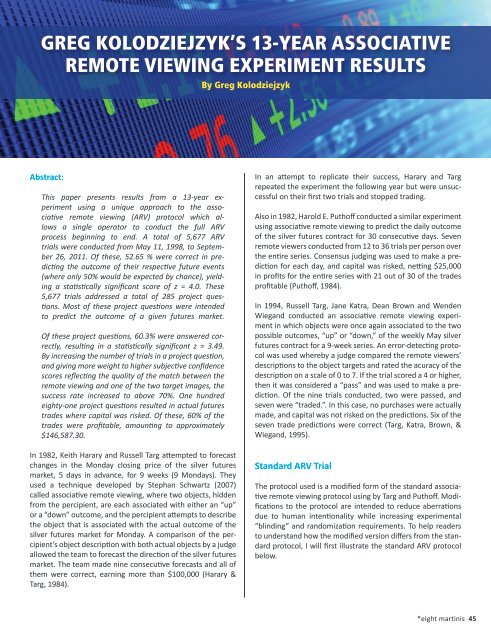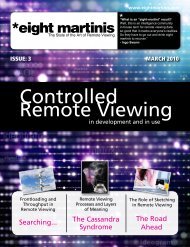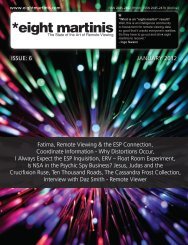Download FREE now! - Eight martinis is a magazine
Download FREE now! - Eight martinis is a magazine
Download FREE now! - Eight martinis is a magazine
Create successful ePaper yourself
Turn your PDF publications into a flip-book with our unique Google optimized e-Paper software.
GREG KOLODZIEJZYK’S 13-YEAR ASSOCIATIVEREMOTE VIEWING EXPERIMENT RESULTSBy Greg KolodziejzykAbstract:Th<strong>is</strong> paper presents results from a 13-year experimentusing a unique approach to the associativeremote viewing (ARV) protocol which allowsa single operator to conduct the full ARVprocess beginning to end. A total of 5,677 ARVtrials were conducted from May 11, 1998, to September26, 2011. Of these, 52.65 % were correct in predictingthe outcome of their respective future events(where only 50% would be expected by chance), yieldinga stat<strong>is</strong>tically significant score of z = 4.0. These5,677 trials addressed a total of 285 project questions.Most of these project questions were intendedto predict the outcome of a given futures market.Of these project questions, 60.3% were answered correctly,resulting in a stat<strong>is</strong>tically significant z = 3.49.By increasing the number of trials in a project question,and giving more weight to higher subjective confidencescores reflecting the quality of the match between theremote viewing and one of the two target images, thesuccess rate increased to above 70%. One hundredeighty-one project questions resulted in actual futurestrades where capital was r<strong>is</strong>ked. Of these, 60% of thetrades were profitable, amounting to approximately$146,587.30.In 1982, Keith Harary and Russell Targ attempted to forecastchanges in the Monday closing price of the silver futuresmarket, 5 days in advance, for 9 weeks (9 Mondays). Theyused a technique developed by Stephan Schwartz (2007)called associative remote viewing, where two objects, hiddenfrom the percipient, are each associated with either an “up”or a “down” outcome, and the percipient attempts to describethe object that <strong>is</strong> associated with the actual outcome of thesilver futures market for Monday. A compar<strong>is</strong>on of the percipient’sobject description with both actual objects by a judgeallowed the team to forecast the direction of the silver futuresmarket. The team made nine consecutive forecasts and all ofthem were correct, earning more than $100,000 (Harary &Targ, 1984).In an attempt to replicate their success, Harary and Targrepeated the experiment the following year but were unsuccessfulon their first two trials and stopped trading.Also in 1982, Harold E. Puthoff conducted a similar experimentusing associative remote viewing to predict the daily outcomeof the silver futures contract for 30 consecutive days. Sevenremote viewers conducted from 12 to 36 trials per person overthe entire series. Consensus judging was used to make a predictionfor each day, and capital was r<strong>is</strong>ked, netting $25,000in profits for the entire series with 21 out of 30 of the tradesprofitable (Puthoff, 1984).In 1994, Russell Targ, Jane Katra, Dean Brown and WendenWiegand conducted an associative remote viewing experimentin which objects were once again associated to the twopossible outcomes, “up” or “down,” of the weekly May silverfutures contract for a 9-week series. An error-detecting protocolwas used whereby a judge compared the remote viewers’descriptions to the object targets and rated the acuracy of thedescription on a scale of 0 to 7. If the trial scored a 4 or higher,then it was considered a “pass” and was used to make a prediction.Of the nine trials conducted, two were passed, andseven were “traded.”. In th<strong>is</strong> case, no purchases were actuallymade, and capital was not r<strong>is</strong>ked on the predictions. Six of theseven trade predictions were correct (Targ, Katra, Brown, &Wiegand, 1995).Standard ARV TrialThe protocol used <strong>is</strong> a modified form of the standard associativeremote viewing protocol using by Targ and Puthoff. Modificationsto the protocol are intended to reduce aberrationsdue to human intentionality while increasing experimental“blinding” and randomization requirements. To help readersto understand how the modified version differs from the standardprotocol, I will first illustrate the standard ARV protocolbelow.*eight <strong>martin<strong>is</strong></strong> 45







